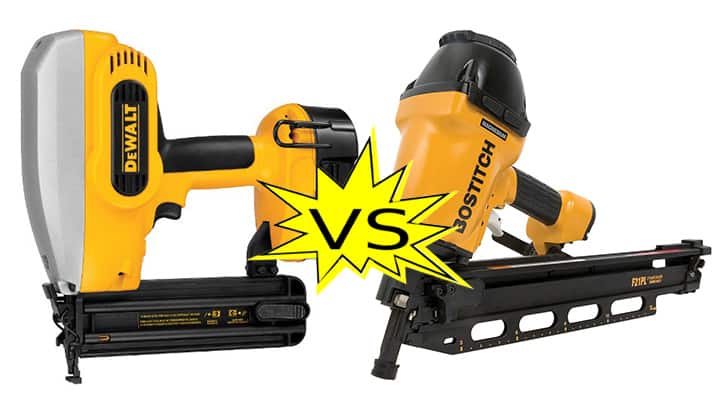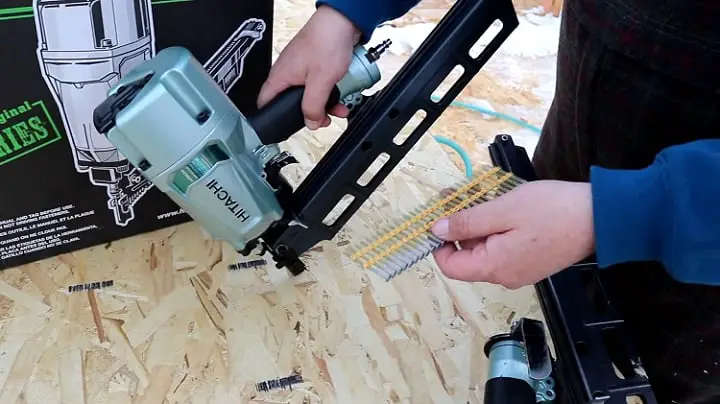I love creating free content full of tips for my readers, you. I don't accept paid sponsorships, my opinion is my own, but if you find my recommendations helpful and you end up buying something you like through one of my links, I could earn a commission at no extra cost to you. Learn more
Different categories of nailers are made for different purposes and tasks. As such, the brad nailer and the framing nailer are both quite different from each other. The only common thing between them is that they both shoot nails into the woods.
Comparing brad nailer vs framing nailer and which one is better largely depends on your workspace and needs. So, you can’t say that one is better than the other.

In this post we'll cover:
Basic Introduction
To start, let’s walk you through a basic introduction to both the nailers.1. Brad Nailer
A brad nailer is a handy tool primarily used in casual household works and fixes. These are the most widely used nailers as they can be used for multiple purposes and serves both casual and professional carpenters.2. Framing Nailer
A framing nailer is a pin nailing tool used mainly by professionals on large-scale projects. These offer a lot of versatility and reliability that satisfy professional work. This type of nailer isn’t seen very much as only big projects and serious pros use them.Purpose
We’ll now talk about the primary purpose of each nailer to help you understand which one would be the right pick for your kind of job.Why Use a Brad Nailer?
As you can probably already tell from the introduction, a brad nailer is more focused and targeted towards casual use rather than professional use. Although many professionals use it for day-to-day use, it is seldom used in large-scale projects. A brad nailer shoots thin 18 gauge nails that barely leave any trace when applied. That makes it very appealing for small projects that don’t engage heavy woods. It conserves the aesthetics of the project. Another plus point is that you can remove brads quite easily, so you can fix any misplaced pins right away. These can also be used as temporary seals to hold pieces of wood while the adhesive dries. All in all, a brad nailer is focused more on small projects, household fixes, and day-to-day usage.Why Use a Framing Nailer?
The framing nailer is explicitly made for professional use and big projects. As a result, they are very much unsuitable for casual use. The reason mostly comes down to the fact that it is much harder to operate, and the nail sizes are not compatible with home use. Framing nailers use thick nails between 21-28 gauges, and they can be set to shoot at different angles. This control over shooting angle is what separates it from other nailers. You can set the angle to a lower degree for tighter workspaces and get out of sticky situations. The thick nails are super strong, and they can hold large, heavy pieces of wood without any strain. These exclusive features make it clear that it is indeed work-focused and built to handle big projects and operations.Work Scenarios
It should be pretty clear that both have very different purposes and are made to work in different situations. We’ll now brief on the various work scenarios for each of them.1. Brad Nailer Working Scenarios
As mentioned before, a brad nailer is more of a casual accessory/tool rather than a professional tool. It can shoot precise nails, which makes it very much eligible for minor fixes and projects. The typical working scenarios include fixing a broken doorknob, wooden chair, and cabinet drawer. You can also find yourself nailing picture frames. It is handy for school and home projects as it can precisely shoot nails, which are not noticeable. Brad nailers work very fast, so you can complete any lengthy nailing tasks within minutes.2. Framing Nailer Working Scenarios
Since the framing nailer is so dedicated mainly to professional use, its work scenarios are pretty limited. However, it is a necessity in large-scale projects.
Comparison
And now we’ll be directly comparing these two nailers to differentiate the differences.| Brad Nailer | Framing Nailer |
| Used mainly for casual works but can also be used professionally | Utilized only for professional work and is a necessity in large workspaces |
| It uses 18 gauge pins | Supports pins from 21-28 gauges |
| Small footprint allows for working in tighter spaces | Has angle adjustability that enables it to work under any spaces |
| It does not leave any visible trace of the pin once applied | The pinhead is left on top of the wood, so it’s very visible |
| Can seal woods of medium size and weight | Can attach all kinds of woods regardless of size and weight |
Which One Is Better for You?
Now that we have laid down all the facts and info about the brad nailer and the framing nailer, it’s time to decide which one is better for you. From the comparison, it’s evident that you should go for the best brad nailer if you are starting and you’re primarily looking to nail things around the house. It is more user-friendly and versatile. On the other hand, if you are a professional in wood jobs or plan to work on large projects, you will be more appealed by the framing nailer. It is incredibly powerful and can drive nails into any thickness of the wood. Though it can be a bit hard to use, your work will benefit so much once you get the hang of it. Aside from personal preference, a brad nailer offers more opportunities than framing nailers, so they are the better choice for most people.Conclusion
Needless to say, the brad nailer vs framing nailer conversation ends on personal preference and what kind of work you will be doing. The brad nailer is usually a better pick if you’re just starting and don’t know which one to get. Regardless, we hope that we have helped you decide which one is better for you.I'm Joost Nusselder, the founder of Tools Doctor, content marketer, and dad. I love trying out new equipment, and together with my team I've been creating in-depth blog articles since 2016 to help loyal readers with tools & crafting tips.
